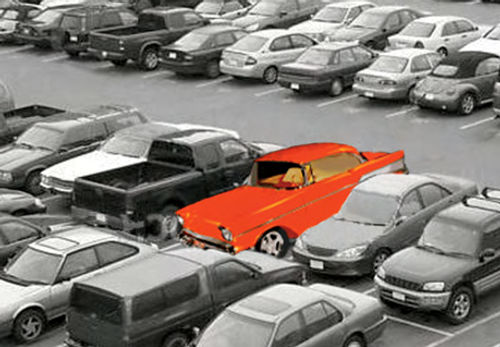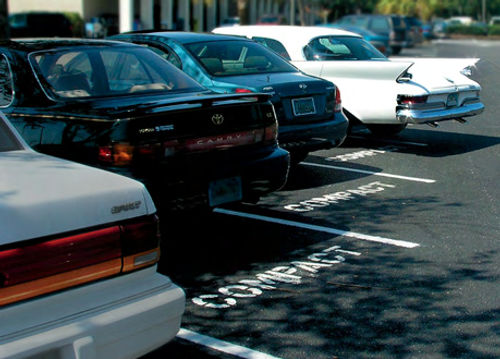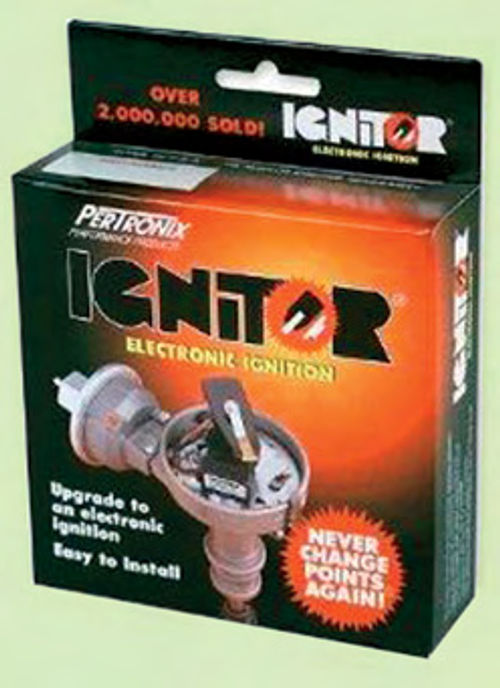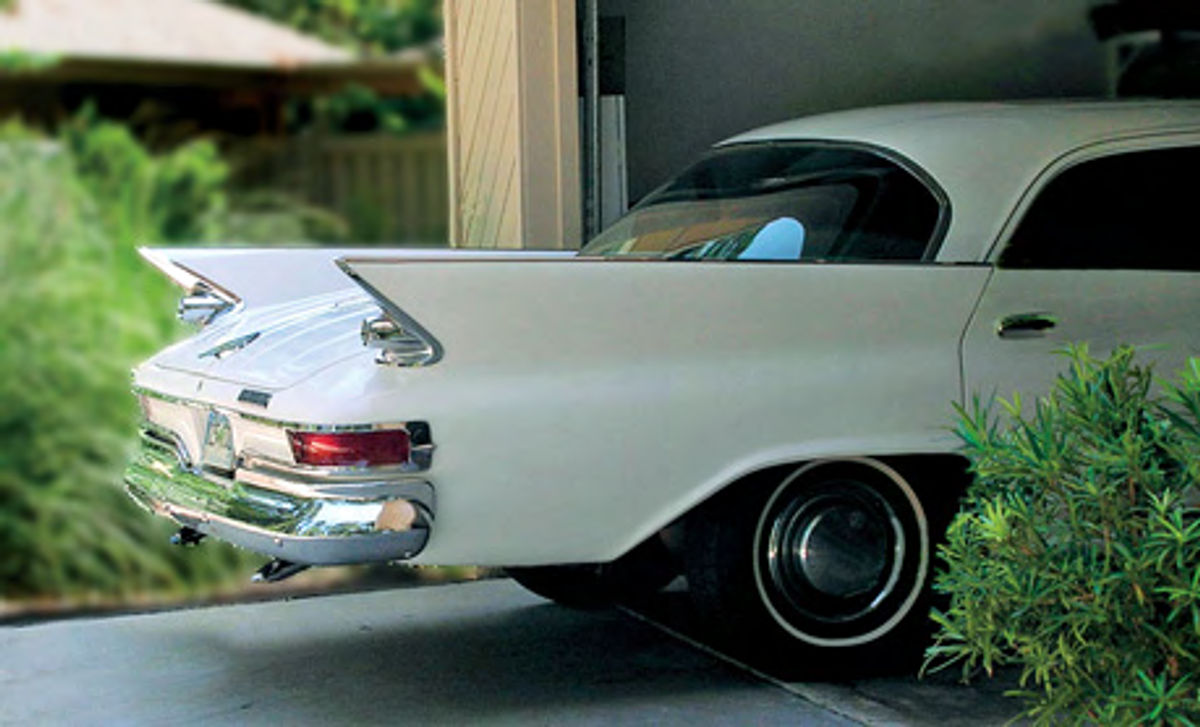A Vintage Vehicle as a Daily Driver?
Depending on Your Circumstances, It Could Be the Way to Go. So Consider Your Situation & Your Vehicle’s Condition.
WOULDN’T IT BE fantastic to drive your vintage vehicle every day instead of only occasionally? I’m sure that thought has crossed the minds of most of us.
There is little doubt that given enough money and effort, we could make it happen. But whether or not it’s sensible depends on several factors that require objective consideration.
So before we discuss the actual preparation of a vintage vehicle for frequent use, we should answer a few basic questions to determine if it’s worth attempting given your particular set of circumstances. It’s not for everyone, so let's see if it might work for you.
Exactly How Will You Use This Daily Driver?
The term “daily driver” does not have a single, universally agreed upon definition. It is somewhat like the terms “classic” and “original”—it means different things to different people.
Some owners may plan to use their vehicles to run short errands around residential areas at nominal speeds. For them, it likely won’t be a huge switch from hobby car to daily driver.
On the other hand, for those who plan to use their vehicles to commute to work every day in rush hour traffic or at highway speeds, it’s only natural to anticipate more effort in preparing those vehicles for the stress of constant use.
The vehicle probably will need repairs or modifications before being placed into use. Ongoing preventative maintenance will also be a more important factor as the requirement for higher reliability greatly increases.
Weather may play a large, expensive part in using the vehicle routinely as well. If you live in a hot climate, the lack of an air conditioner—something that’s tolerable on the occasional trips you make in your hobby vehicle—may become intolerable if you make long daily trips in the heat of the day. You would then have to ask yourself if you’re prepared to add A/C to your ride.
Given this and other drawbacks that weather extremes can present, you may prefer to limit your use to seasonal driving. This means parking the car during the summer months in the south or storing it in the winter in the north.
Are You Willing To Accept The Wear And Tear That Come With Racking Up Thousands Of Milesr?
Many vintage vehicles still on the road are there because the earlier owners didn’t drive them routinely. If you decide to drive your vehicle every day, it’s inevitable that it will soon begin to show the effects of constant use.
If you agonize over every minor flaw in your vehicle’s paint, you will have a difficult time driving it everyday.Even if you avoid crowded parking lots, sooner or later dents and scrapes will appear. Acid rain, tree sap and bird droppings will be constant threats. You can either accept the deterioration or spend the extra effort to clean and polish often.
My experience with car covers shows them to be enough of a nuisance that I have discontinued using them after a few days. There also is the danger of dirt getting underneath them. When the wind blows, the cover may shift and grind the dirt into the paint.
Long-term sun exposure damages paint and upholstery, especially vinyl dashes. Sun guards and tinted glass help minimize the damage, but won’t eliminate it.
It’s an unfortunate fact but, if you plan on using your vintage driver a lot, you must come to grips with the additional wear and tear that will inevitably result.
Are You Willing to Accept Some Loss of Automotive Technology?
We need to keep in mind that some of the quirks and features that make our vintage vehicles so much fun to drive every week or two may lose some of their charm if experienced every day. A vintage vehicle calls for a mindset change from the hop-in-and-go attitude of most modern drivers to one of more involvement and effort.
Readers of Auto Restorer are in a much better position than the general population to predict whether daily driving of a hobby vehicle is sensible or not. Most of us have experience in owning, driving and maintaining older vehicles. Our expectations should be more clear and reasonable. We know that we are not talking about a lack of cup holders, navigation screens or premium sound systems. Our interest is in maintenance requirements, safety features, comfort items and possibly fuel consumption.
The Best Vehicle for Daily Driving
If you already own a hobby vehicle, the matter of choosing a daily driver candidate is likely resolved. There is a big advantage to using a car that you are familiar with as a candidate to prepare for everyday use. You already know weaknesses that you have worked around and can identify what you should improve to use it daily. You likely already have some special tools and workshop manuals for that vehicle.
If you plan to buy the vintage vehicle that you will drive, think carefully about what you need.
Of course, the age of the car that you select will be a large factor in its suitability. The older the vehicle, the further its design maybe from today’s travel conditions. This translates to limited use or more modification of the car or truck to accommodate the modern highway environment.
If you need to keep expenses toa minimum, remember that the more basic the model is, the fewer things there are to fail. Also, vehicles that were economical to drive when new probably will be economical to drive today.
However, basic transportation vintage vehicles may be difficult to find today even though there were more built than high-end, loaded models. The basic ones were probably driven until they wore out or rusted away. The top of the line cars were more apt to be garaged, given more ongoing care and possibly stored away by affluent owners.
Four-door models often make good cars to start driving daily. They were less apt to have been driven hard by young drivers. If an original owner planned to drag race a car, he wouldn’t start with a four-door sedan.
Don’t overlook vintage trucks if they might fit your needs. They are very basic mechanically and, if you can find one that isn’t worn out, a few modifications may make it usable for daily driver duty. But keep in mind that unmodified ones tend to be noisy, have high steering forces, and are equipped with gearing designed more for pulling heavy loads than highway cruising. There are many aftermarket parts that will bring them in line with what you need.
First-timers should keep the challenges to a minimum. A vintage vehicle on the newer end of the spectrum would be a good choice. If that goes well, you can always sell it and try an older one with a few more challenges.
Financial Issues

By now you probably are wondering what all this will cost.Actually, the financial side of this project is not as bleak as it first appears. Consider that, if you maintain your vehicle well, you will likely incur little or no depreciation. Modern everyday cars decrease in value— usually at an alarming rate. If you compare a vintage vehicle with a leased vehicle, consider how much maintenance or updating that you can do for the price of just one monthly payment.
Although older vehicles may require more maintenance, the cost of parts and the ease of repair are less than with modern cars. Even if you don’t repair the vehicle yourself, you will likely not need expensive repairs that require high tech or dealer shops.
The cost of mechanical parts often is surprisingly low for vehicles that once were popular. By using the same part for several makes and yearly models, manufacturers kept prices down. Today, that means that we can find that part at an auto parts store or recycle yard at a reasonable price. Sheet metal and trim parts, on the other hand, will not be as easily available because they tend to be more specific to a model.
Even with these financial advantages, it is possible to invest more in your vehicle than you can sell it for. However, if your goal is to have an interesting frequent driving experience in a safe, reliable vehicle, it may be worth it.
Fuel costs of vintage vehicles vary greatly. If your choice for a daily driver is a 1960s muscle car or a 1970s boulevard cruiser, you may find that it gets only 10 miles per gallon. Additionally, it may require premium gas, an octane booster or other additives. On the other hand, many older vehicles get better fuel economy than some modern vehicles such as SUVs and large pickup trucks.
Fuel costs, of course, can become a major variable in your operating expenses if you drive many miles per week.
Vintage Insurance
You will need to solve the question of insurance coverage before you begin to drive your hobby vehicle as everyday transportation.
Unfortunately, the surprisingly cheap specialty policy that covers your hobby vehicle definitely will not be valid when you use it as your daily driver. After all, that low cost reflects the low risk that the company has to cover for occasional recreational use.
You probably remember that most collector vehicle policies specifically prohibit use for daily transportation. The temptation to cheat is strong…but don’t. The risk of denial of a claim is too high.
Insurance for daily driver liability—the cost of injury and property of others—is not difficult to find. Many mainstream companies will insure you for whatever liability amounts you wish at reasonable rates. The difficulty arises when shopping for collision and comprehensive insurance—that is, the cost of your car in case of collision, theft or other damage.
Many companies are not interested in covering vintage vehicles for collision, probably due to the small market and lack of repair cost data. If they do cover daily use of older vehicles, your payment in case of a claim may well be based on “Stated Value;” not “Agreed Value.”
Stated Value is based on information from their reference guides. Therefore, if you have a restored, rare or updated car its value will be woefully low in case of loss because the insurance company will regard it as nothing more than an aging, used vehicle.

Agreed Value is what you want. It is based on the true value of the vehicle that you and your insurance company agree upon before the policy is issued. They may require a professional appraisal to establish that value.
Contact your insurance agent about what you want to do. Your current company may agree to cover you with an Agreed Value policy if you have other policies with them and you have a good driving record. If not, a broker may be able to find another company that will.
However you solve your insurance needs, read your policy carefully to ensure that you understand its contents so you don’t have any surprises if you ever need to file a claim.
Reliability Issues
For many owners the primary concern about vintage daily drivers is the risk of becoming stranded in case of a breakdown. By starting with a basically sound car, making initial repairs or modifications as required, and performing proper preventative maintenance, you should keep reliability at an acceptable level. Few people would expect a vehicle that is decades old to be as dependable as a new one, but with effort, the chance of a breakdown can be low.
Before being placed in daily service, most vintage vehicles should be thoroughly inspected and components refreshed or replaced as needed. An excellent place to start is by completing the manufacturer’s 30,000-mile checklist for scheduled maintenance located in the Factory Workshop Manual or Owner’s Manual. Consumable items such as fluids, filters, belts, hoses and batteries should be replaced unless you know them to be in excellent shape.
Larger, more expensive items such as tires, the clutch lining, and brake shoes or pads should be checked carefully and replaced if at all questionable. Many would last several years at the rate of wear they would have received when used in a hobby car, but will require work soon if subjected to the accelerated wear of everyday use.
Ignition components are probably responsible for more breakdowns on vintage vehicles than any other system. So why not start with all-new components to enhance reliability?By replacing spark plugs, wires, the distributor cap, rotor, points and condenser at one time, you will have improved the dependability of your engine significantly.
One method to check that ignition components are sound is to raise the hood at night with the engine running. Without any ambient light, bad connections or cracked insulation may be discovered by the sparks emitted.
Other electrical items also deserve special attention. Connections corrode and insulation cracks due to age as much as use and are not always obvious with a quick visual inspection.
Vintage vehicles often are only driven in nice weather, but you may not have that option with a daily driver. To verify that the electrical system is up to the task of everyday driving, drive it locally during a rain shower at least once before placing it in daily service.
I like to put the biggest battery that will fit in the vintage vehicles that I drive routinely.
Another hurdle to the reliability of a vintage vehicle daily driver is insufficient cooling. It may be possible to get by with marginal cooling in a hobby car if you avoid parades and long lines of traffic at cruise-ins. However, when you need to drive in the real life stop-and-go world that includes traffic jams, you must keep an efficient cooling system.
To test if your present system is sufficient for reliable everyday driving, start by letting the engine idle with no cooling air supplied by wind. You can do this in your garage—with the door open, of course. If it hasn’t overheated after a half hour, it is probably going to be OK even in a traffic jam. This Test can also uncover a vapor lock problem if you shut the engine off and try to restart it 10 to 15 minutes later. It is better to discover this in your driveway than when you are in a hurry in the middle of city traffic. (For more on overheating and vapor lock, see page 9.)
Some parts of the cooling system,such as a thermostat and radiator cap, are so cheap that it often pays simply to replace them. New hoses will ensure that they won’t be spongy and collapse at high flow rates on the open road.
If you still have any apprehension regarding whether your cooling system can handle any driving situation, check it out under actual driving conditions before relying on it for critical trips.If necessary, delve deeper into the problem realizing that the answer may be a new or rebuilt radiator, a water pump or cleaning out of the engine block passages.
To check if the fuel delivery system is working properly, perform the fuel pressure and volume test found in nearly every workshop manual. Those manuals will give the normal pressure reading and the amount of fuel that should be supplied to the carburetor when the engine is cranked by the starter for a specified period of time.
The fuel pump is one engine part that is often replaced unless it is known to be nearly new. With modern gas usually containing alcohol, you want to be sure the diaphragm in the pump is not made from old material. Be sure that the one you install has been rebuilt recently and not been stored for many years.
Two components rarely used in many hobby cars but important to daily drivers are the heater and the windshield wiping system. If you only use your vintage vehicle in good weather in the summer, you may not know their condition. But even in areas with moderate temperatures, heat for the defroster will be necessary for daily driving in humid conditions.
To check the wipers,spray water from a hose as you operate them. This will show how effective they are and will prevent scratching the glass if the blades are bad.
Carefully inspect all rubber weather stripping. Some of it may have dried out and cracked during long periods of good-weather-only style driving and gone unnoticed.
Modify as Required
To this point, we have been discussing repair items. Usually, returning systems back to original condition is all that is needed for a practical car. Sometimes though, we would prefer a better way and improved parts may be available to solve the problem.
An example is the electric ignition module, the most popular of which is PerTronix (pertronix.com).
The original mechanical points system found in most vintage vehicles worked well for many decades as long as it was adjusted and lubricated properly. Unfortunately, it was a high-maintenance system. Many owners have replaced it with the PerTronix electronic system with good results. If the new system should fail or you want to go back to the original works, it is a simple matter to switch it back to the mechanical type.
Modifying the fuel delivery system to include an electric fuel pump is another helpful modification on most vintage vehicles. This helps to ensure quick starts if the vehicle sits idle for a while and will help prevent vapor lock. An electric pump is also a good backup if the mechanical pump fails.
Another add-on modification that may be worthwhile is an electric radiator cooling fan. If the cooling capacity of your vintage vehicle is questionable after you have repaired the system as best you can, an auxiliary fan forcing air through the radiator may be the answer to your problem. They can be controlled thermostatically or manually by a switch in the cabin.
Vintage Vehicles of the1950s and’60s brought the start of warning lights to replace gauges. Now that these vehicles are several decades old, most drivers would like more information about the condition of the vehicle systems. Aftermarket gauges supply more information than warning lights. They can be placed in a panel hinged to the bottom of the dashboard or even hidden in the glove box ready for reference when desired.

As discussed earlier, many potential owners of vintage daily drivers live in climates that would make a lack of air conditioning a deal breaker.
Furthermore, original working units may not withstand constant use for very long. Owners wishing to add or replace an air conditioner can choose between units designed to hide behind the dash or those attached under the dash. It will be a sizable investment, but it may be necessary in order to change a hobby car into practical transportation.
Safety Issues
Whenever anyone considers the safety of vintage vehicles, they are usually thinking about brakes. And well they should. Braking ability is where vintage vehicles differ the most from modern cars. To be fair to early brake designers, today’s vintage vehicle brakes often are not maintained or adjusted properly. Also, we have become so accustomed to modern power brakes that the feel of older, often manual, brakes is strange to us.
Some owners make a case for leaving the brakes of a hobby vintage vehicle original and maintaining them properly.
However, most would agree that today’s daily driving conditions dictate that vintage vehicles should be updated with disc brakes, at least on the front wheels. These, in addition to a dual circuit brake lines system, will go a long way toward increasing the safety of a vintage daily driver.
Few vehicles built before 1980 have adequate restraint systems by today’s standards. However, several companies make lap and shoulder belts readily available and they are relatively easy to install.
On the other hand, aftermarket add-on airbags are not available and may never be due to liability issues.
The majority of owners prefer radial tires over bias ply tires. They track straighter, grip better and offer a better ride. They may require adjustment to alignment settings.
Vintage vehicles usually will benefit from new, brighter headlights and tail lights. Halogen headlights are brighter but draw more amperage from the electrical system. LED tail lights are bright and don’t draw much current.
Third stop lights are effective and are usually easy to install in the rear window.
A Few More Tips to Consider
Here are some tips to help make your vintage daily driver experience more pleasant:
• Buy a Factory Shop Manual and keep it in the car. Even if you don’t do your own maintenance, whoever does will appreciate the procedures and specifications included in the manual.
• Keep a small, basic tool kit in the trunk. It’s surprising how many problems can be solved with only a few tools. The same is true for keeping a few high-wear replacement parts, such as ignition parts, that might strand you.
•It may take some effort to overcome the dread of a breakdown. If you are the cautious type, get a roadside service policy such as offered by AAA that will help you with problems like no-start or towing. A cell phone and a credit card may come in handy, too.
• To help ease your mind when you start your daily driver project, plan a few short trips when you aren’t under a deadline. As you complete more trouble-free trips, your confidence will grow. Soon you will have faith in your car’s ability to get you to any destination and, more importantly, to bring you back.
• Keep in mind that driving your vintage vehicle as practical transportation does not have to be a lifelong project. You can continue it as long as it is enjoyable and it makes sense, and you can return your vehicle to its original hobby role if you so choose. In the meantime, you should have fun and generate many memorable experiences.
















